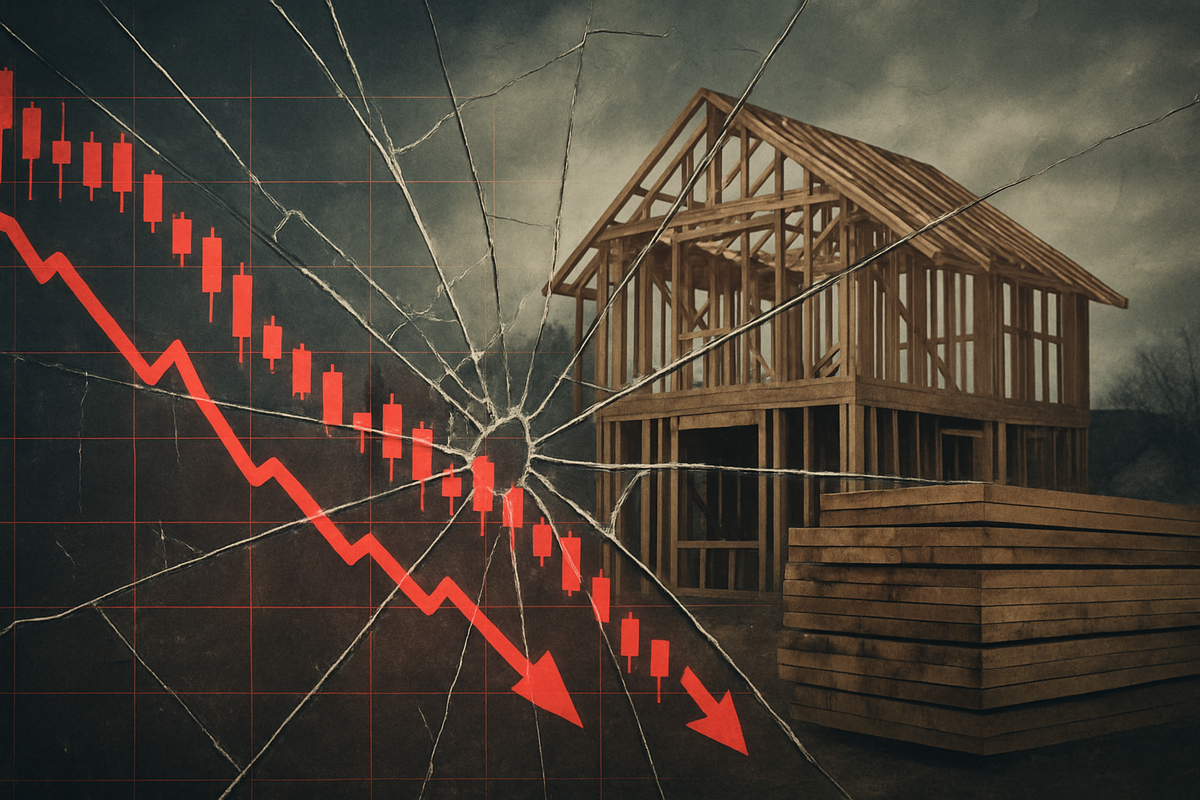
Boise Cascade (NYSE: BCC), a leading manufacturer of wood products and wholesale distributor of building materials, has seen its stock price repeatedly breach new 12-month lows in early October 2025. This downturn, with shares hitting $72.15 on October 13, 2025, signals significant challenges within the broader timber and building materials sector, raising concerns among investors about the industry's resilience in a volatile economic climate. The persistent decline underscores the pressures faced by companies heavily reliant on new home construction and fluctuating material prices, prompting a reevaluation of market expectations for the sector.
Boise Cascade Grapples with Prolonged Market Downturn
The precipitous fall in Boise Cascade's stock has been a developing story over recent months, culminating in multiple new 12-month lows in October 2025. On October 13, shares touched $72.15, closing at $72.54, following a series of similar dips, including a close of $72.32 on October 10 and $74.52 on October 7. This consistent downward trend, which began to accelerate through September with lows like $76.15 on September 29, paints a clear picture of sustained investor apprehension.
Key players in this unfolding narrative include Boise Cascade (NYSE: BCC) itself, its extensive network of customers in the construction industry, and the financial analysts who closely track its performance. Initial market reactions have been mixed; while several analysts, including DA Davidson, BMO Capital Markets, and Truist Financial, have lowered their price targets, many still maintain a "Moderate Buy" or "Buy" rating, suggesting a belief that the stock may be undervalued despite its bearish moving average trends. This sentiment persists even as the company has attempted to bolster investor confidence through an increased quarterly dividend and share buyback programs.
The primary drivers behind this prolonged decline are multifaceted, deeply rooted in the current state of the timber and building materials sector. Weak demand and pricing for wood products, particularly in the engineered wood products (EWP) segment, have significantly impacted Boise Cascade's profitability. The company's Wood Products segment saw sales drop 9% and income plummet 81% in Q2 2025, leading to a lowered Q3 profit forecast. The broader building materials market is experiencing a significant slowdown, exacerbated by persistently high mortgage rates that are stifling new home construction. With U.S. building permits decreasing, the demand for Boise Cascade's products, which are highly correlated with single-family home construction, has consequently waned. Compounding these issues are lower-than-expected earnings—Boise Cascade has reported negative results for four consecutive quarters—increased competition in the EWP market, and overarching economic uncertainty driven by recession fears and job market revisions.
Navigating the Shifting Sands: Potential Winners and Losers in a Challenging Market
The current headwinds buffeting Boise Cascade (NYSE: BCC) are not isolated, but rather indicative of a broader reckoning within the timber and building materials sector. High mortgage rates, persistent inflation, and a consequent slowdown in new home construction are creating a highly selective environment, where companies with diversified revenue streams, strong balance sheets, and strategic market positioning are better equipped to weather the storm.
Companies heavily reliant on the volume of new residential construction and the sale of commodity wood products are facing significant challenges. Beyond Boise Cascade (NYSE: BCC), which is already experiencing the direct impact of slowing demand in engineered wood products (EWP) and overall building materials, other major players like West Fraser Timber Co. (NYSE: WFG) are also feeling the squeeze. As one of the largest global producers of softwood lumber and oriented strand board (OSB), West Fraser's profitability is highly sensitive to the North American housing market. Reduced construction volumes directly translate to pressure on lumber prices and, consequently, their bottom line. Furthermore, smaller, less diversified producers of raw timber or undifferentiated commodity wood products are particularly vulnerable to price fluctuations and increased operational costs, with mill closures across the industry serving as a stark reminder of these pressures.
Conversely, certain companies are demonstrating resilience or are strategically positioned to benefit from the evolving market dynamics. Weyerhaeuser (NYSE: WY), a timberland REIT and one of the largest private owners of timberlands, exemplifies this. Its vertical integration, which allows it to harvest its own logs and process them into finished products, provides better cost control and margin capture. U.S. tariffs on Canadian lumber also indirectly benefit Weyerhaeuser's domestically focused production. Similarly, PotlatchDeltic Corporation (NASDAQ: PCH) and Rayonier (NYSE: RYN), both timberland REITs, benefit from diversified revenue streams from timberlands and real estate, offering a buffer against the volatility of the manufacturing segment.
Beyond timberland owners, companies with diversified product portfolios or a strong focus on the repair and remodeling (R&R) market are also showing strength. UFP Industries (NASDAQ: UFPI), with its exposure to industrial packaging and retail products alongside construction, offers a more robust business model less solely dependent on new housing starts. Trex Company, Inc. (NYSE: TREX), a leader in wood-alternative decking and railing, is particularly well-positioned as it caters to the R&R market, which tends to remain active even when new construction falters. Lastly, Builders FirstSource (NASDAQ: BLDR), as the largest U.S. supplier of building materials, while exposed to the housing market, benefits from its sheer scale and ability to offer prefabricated components that can provide efficiency and cost savings to builders, making it a critical partner in any construction environment.
Broader Implications and Industry-Wide Tremors
Boise Cascade's (NYSE: BCC) recent stock performance is not merely an isolated corporate challenge but a stark indicator of profound shifts and enduring pressures within the broader timber and building materials sector. This downturn is deeply intertwined with several macroeconomic forces and supply-side dynamics that are reshaping the industry landscape in late 2025.
The most significant broader trend is the persistent slowdown in the U.S. housing market. Elevated interest rates continue to suppress new home construction, directly impacting the demand for lumber and wood products. While some stabilization has been observed, U.S. housing starts, particularly for single-family homes, have seen year-over-year declines through the first half of 2025. This directly affects companies like Boise Cascade (NYSE: BCC), which are heavily reliant on residential construction. Compounding this, the industry has experienced significant capacity reductions, with over 5 billion board feet of softwood lumber capacity shuttered in North America in 2023-2024, alongside ongoing labor shortages and logistical bottlenecks. Despite these challenges, there's a simultaneous push towards technological advancements, automation, and a growing demand for sustainable wood products like Cross-Laminated Timber (CLT), signaling a long-term strategic evolution within the sector.
The ripple effects of these conditions extend across the entire value chain. Competitors such as Weyerhaeuser (NYSE: WY), West Fraser Timber Co. (NYSE: WFG), and Canfor (TSX: CFP) are exposed to similar market dynamics, including fluctuating housing starts and the impact of tariffs. While some, like Weyerhaeuser, benefit from vertical integration and timberland ownership, all face the common challenge of constrained demand and volatile pricing. Homebuilders, as crucial partners, are directly affected by the availability and cost of materials, moderating their construction paces to align with sales and grappling with affordability issues for consumers. Suppliers of raw timber and building material retailers also experience dampened demand and sales volumes. Regionally, these downturns can have significant economic impacts, leading to mill closures and job losses in timber-dependent communities, a historical pattern that re-emerges in challenging times.
Adding another layer of complexity are significant regulatory and policy shifts. Effective October 14, 2025, President Trump has imposed new Section 232 tariffs on timber, lumber, and certain derivative products, including a 10% tariff on softwood timber and lumber imports, and higher tariffs on upholstered wooden products and kitchen cabinets. These tariffs, particularly the 34.5% duty on Canadian imports, aim to bolster domestic production and reduce reliance on foreign suppliers. Concurrently, an executive order calls for a 25% increase in timber production from federal lands, achieved by fast-tracking logging permits and rolling back certain environmental regulations. These policy changes, while intended to support domestic industry, have sparked environmental concerns and are expected to disrupt global wood trade, particularly impacting Canada.
Historically, the timber industry is no stranger to cyclical downturns. The early 1980s recession offers a compelling parallel, where high interest rates led to a severe slump in the wood products market, significant price drops, increased Canadian competition, and widespread mill closures and job losses. The 2008 financial crisis similarly devastated the sector, leading to substantial job losses. These historical precedents highlight the industry's vulnerability to macroeconomic forces but also demonstrate its capacity for resilience, driving efficiency improvements, technological adoption, and consolidation in response to adversity.
What Comes Next: Navigating the Future of Timber and Construction
The path forward for Boise Cascade (NYSE: BCC) and the wider timber and building materials sector is characterized by both immediate challenges and compelling long-term opportunities. In the short term (late 2025 to 2026), the industry is expected to remain in a mixed environment, grappling with the lingering effects of high interest rates and a constrained housing market. While a gradual easing of mortgage rates into the mid-5% to 6% range by late 2026 is anticipated, affordability will continue to be a significant hurdle, leading to only modest rebounds in existing-home sales and new single-family housing construction. Companies will need to maintain a sharp focus on cost management, operational efficiency, and supply chain resilience to navigate stable timber demand alongside persistent price volatility.
Looking further ahead, the long-term outlook (2027-2030 and beyond) is considerably more optimistic, driven by transformative trends. The green building materials market is projected for substantial growth, fueled by increasing environmental awareness, stringent regulations, and a demand for energy-efficient structures. This will particularly benefit natural materials like wood and engineered timber products such as Cross-Laminated Timber (CLT), which offer significant carbon reduction capabilities. The rise of modular and prefabricated construction is another key driver, promising cost efficiency, reduced construction times, and eco-friendly practices, with wood often being a material of choice. Furthermore, technology integration, including automation, AI, and Building Information Modeling (BIM), will continue to enhance efficiency across timber management, design, and construction, while increasing global demand for timber by 2050 is expected to put upward pressure on prices.
To capitalize on these long-term trends and mitigate short-term headwinds, companies in the sector must undertake strategic pivots. Embracing sustainability and green building practices is paramount, requiring investment in low-carbon solutions, circular construction, and certifications (e.g., LEED, FSC). Significant investment in technology and automation, including prefabrication and digital tools, will be crucial for efficiency and waste reduction. Diversifying product portfolios beyond traditional lumber into higher-value engineered wood products and modular construction solutions, while also strengthening supply chain resilience through diversified sourcing, will be key adaptations. Addressing persistent labor shortages through innovation and training, focusing on the more resilient repair and remodel (R&R) market, and exploring strategic partnerships or acquisitions are also vital for sustained success.
Market opportunities will primarily emerge from the rapid expansion of green building, modular construction, and engineered wood products. Infrastructure development and the consistent demand from the R&R sector will also provide stability. However, challenges such as interest rate sensitivity, raw material price volatility (exacerbated by tariffs), ongoing labor and skills shortages, and competition from alternative materials will continue to test the industry's adaptability. Potential scenarios range from a moderate recovery with sustainable growth (the most likely outcome, with gradual housing market improvement and successful pivots to green building) to prolonged stagnation if economic headwinds persist, or an accelerated transformation leading to high growth if interest rates drop faster and supportive policies are enacted.
The Timber Sector at a Crossroads: Resilience Amidst Volatility
Boise Cascade's (NYSE: BCC) recent descent to a new 12-month low underscores the significant challenges currently facing the timber and building materials sector. This period of volatility, marked by high interest rates, a subdued housing market, and complex trade policies, demands a nuanced understanding from investors and industry participants alike.
Key Takeaways: Boise Cascade's stock has seen a substantial decline through October 2025, reflecting weaker-than-expected earnings, reduced demand for wood products, and intense competition in engineered wood products. This mirrors broader industry struggles, including a slowdown in U.S. housing starts, fluctuating lumber prices, and persistent supply chain and labor constraints. The imposition of new U.S. tariffs on Canadian lumber further complicates the supply landscape, while calls for increased domestic timber production introduce new regulatory and environmental considerations. Despite the immediate headwinds, analysts maintain a cautiously optimistic long-term view for many sector players, often citing underlying value.
Market Moving Forward: The market is poised for a period of cautious recovery, with expectations for a stronger rebound in 2026 as mortgage rates potentially stabilize and housing demand slowly strengthens. However, this recovery will likely be uneven, influenced by ongoing economic uncertainties. The industry is also undergoing a fundamental transformation, with increasing emphasis on sustainability, technological integration (automation, AI, BIM), and the adoption of modern construction methods like modular and prefabricated building. This shift suggests a more resilient and efficient sector in the long run.
Significance and Lasting Impact: The current downturn is a critical juncture, prompting companies to reassess strategies and accelerate adaptations. The lasting impact will likely be a more consolidated, technologically advanced, and sustainability-focused timber industry. Companies that successfully pivot towards green building materials, engineered wood products, and efficient construction methods will be best positioned for long-term growth. The trade policy changes, particularly tariffs, could permanently alter supply chains, favoring domestic production but potentially increasing costs in the short term.
What Investors Should Watch For: In the coming months, investors should closely monitor the trajectory of interest rates, particularly the U.S. Federal Reserve's decisions, as these directly influence housing affordability. Key housing market data, including housing starts, building permits, and existing home sales, will provide crucial insights into demand. Tracking lumber price trends and futures, along with any new developments in U.S. tariff and trade policies, is essential. For Boise Cascade (NYSE: BCC) specifically, future quarterly earnings reports and analyst revisions will indicate its ability to navigate these challenging conditions. Finally, keeping an eye on the health of the supply chain (labor, logistics, raw materials) and the resilience of the repair and remodel (R&R) market will offer a comprehensive view of the sector's evolving landscape.
This content is intended for informational purposes only and is not financial advice





